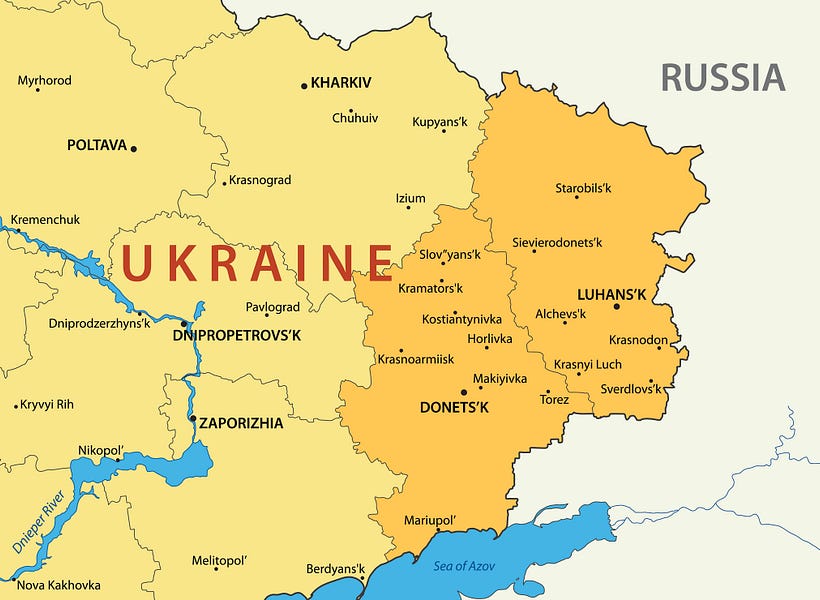The “Battle of the Donbas” has begun.
Thus saith the Ukrainian defense ministry, and Russia agrees: After probing southward toward Izyum, east of Kharkiv, for the last week or so and launching a preparatory artillery barrage in recent days, the Russian army appears to be attacking on a broad front across the region. At this writing, it is too soon to identify a main effort. And, given the scattershot way Russian commanders have approached the war and the battered state of their forces, that may remain a mystery.
If this were the Soviet army of old, these probes and broad-front attacks would serve to uncover or create a crack in Ukrainian defenses through which a powerful and mobile “operational maneuver group” would pour, either seizing decisive terrain or encircling and destroying Ukrainian forces. But even if newly installed Russian commander Gen. Alexandr Dvornikov and his staff remember these ideas, it is unlikely that their forces have the capacity or capability to carry them out.
So what is about to transpire may devolve into a campaign of attrition whose outcome will be determined by two factors: which army suffers the greatest losses and, once exhausted, can reconstitute itself for the next round, which might indeed be decisive. As such, the Donbas fight differs from the defense of Kyiv or even Kharkiv; the armies themselves are the strategic prizes much more than is the terrain.
In this regard, the Russian logistical failure is a severe handicap. A full accounting of these shortcomings is still to come, but a quick review is illustrative. To begin with, the Russian army was not prepared for a long campaign; stocks of all sorts were in short supply and much of what was available was in poor condition, probably as a result of corruption. Even basic individual soldier gear like body armor has been revealed as so decayed as to be useless. Nor is the Russian army structured to sustain long-distance maneuvers.
Moreover, by embarking on operations in the Donbas so soon after withdrawing from Kyiv and Kharkiv, the Russians have had little opportunity to refit the units engaged there. An accurate count of Russian losses in men and equipment cannot be more than educated guesswork, but it is almost certain that the official U.S. numbers do not capture the extent of damage inflicted. Even so, the estimates of Russian battalion tactical groups have been reduced by about one-third, from nearly 150 to less than 100 and perhaps as few as 75, and as many as a third of those remaining are under strength.
Another huge-but-hard-to-measure problem for the Russians is the poor state of morale, particularly among infantry conscripts. There is a growing mountain of anecdotal evidence of Russian soldiers refusing to fight, abandoning equipment, and surrendering to Ukrainian forces. The retreat from Kyiv revealed the physical evidence of indiscipline, from the atrocities of Bucha to slovenly camps and fighting positions. Lacking a professional noncommissioned officer corps, these systemic faults cannot be fixed.
Though themselves under great stress, the Ukrainians continue to show incredible determination and unsurpassed courage. The defense of the Azovstal industrial complex in Mariupol is an Alamo-like moment; Russian surrender ultimatums are a reflection of their reluctance to clear the diehards out of their warren of tunnels and a testament to Ukrainian national determination. President Volodymyr Zelensky’s leadership goes from strength to strength, be it inspiring his fellow Ukrainians or shaming others in the West—most notably the Germans—for their lukewarm support.
The Ukrainian military likewise continues to overachieve. While it lacks the overall material resources of its Russian adversary, it has maximized the potential of what it does possess—keeping its older equipment functioning while repairing and reusing captured Russian gear, an effort with which its Eastern European neighbors have agreed to assist. Ukraine has more than offset previous Russian advantages in drones. Kyiv has also made the most of arms and other supplies received from the West; man-portable anti-armor and anti-air weapons demand great tactical acumen (and courage) to be employed as effectively as it appears the Ukrainian military is doing. And the Ukrainian forces stationed in the Donbas are Kyiv’s most experienced.
At the same time, the pace of Western arms deliveries and the reluctance to transfer more powerful weaponry limit Ukrainian prospects. As the fighting moves eastward, the ability to push supplies forward from Poland through Lviv and other hubs in the west of the country will be constrained and more vulnerable to Russian air attack. Delivering tanks, howitzers, and the needed ammunition will stretch what is already an ad hoc lifeline to a new extreme.
While this is less a battle for the Donbas, it is nonetheless a battle in the Donbas, and the terrain will shape the contest. Much has been made that, compared with the suburbs of Kyiv and Kharkiv, the region is less populated and the ground more open. That might matter more if this were 1944, with the Red Army facing off with the Wehrmacht; two great armies experienced in large-scale, operational maneuvers and forever seeking to fight kesselschlachten—annihilating “cauldron battles” of encirclement. This ambition is most frequently ascribed to the Russians, but they have yet to demonstrate such a capability; the brutality and the artillery are there, but the maneuverability is not. And while only a fool would now undersell the Ukrainians, their prime directives remains defense and the preservation of their army.
Further, the terrain is more complex than many appreciate. The operational area is bisected by the Donets River basin which, while not so great as that of the Dniepr, is quite large, frequently wooded and swampy but also cut by numerous gullies and about 3,000 tributaries. As a result, the geometry of the road network in the region is likewise complex, especially north of the main highway that runs southeast from Kharkiv through Izyum toward Kramatorsk in the northeast of Donetsk. Not surprisingly, the Russians—who remain road-bound, especially in regard to their shoddy logistics vehicles—are making a large effort along this axis, but there will be opportunities for the Ukrainians to conduct the sorts of ambushes they have excelled at, knee-capping the Russians without having to go toe-to-toe. The Russians are also pushing forward into the far northeast along several axes, but the pattern of the roads limits the value of these as supporting attacks, either to one another or to the thrust toward Kramatorsk.
In sum, the Ukrainians have every prospect of holding the Russians off and, even more importantly, preserving the core of their forces. Even if things go badly, the Ukrainians can choose to withdraw from the easternmost front, trading space for time and inflicting tremendous damage on an already weakened Russian army. The Russian army, by contrast, may well be severely crippled by the time this campaign culminates, not just in regard to renewed operations in Ukraine but globally; they have stripped forces from many outposts, including the Kaliningrad enclave. The war thus far has revealed the Russian army to be a brittle thing, and further bloodletting may precipitate a real collapse. Whether Putin declares victory and appeals for an armistice after modest and relatively meaningless territorial gains or simply asserts that he has successfully defended the puppet republics of the Donbas is, of course, not knowable. But after rolling the dice this second time his stack of conventional power-projection chips will be very much reduced.
So what then?
The post-Donbas situation is likely to be unpleasant for Putin but rife with opportunities for President Zelensky, his country, and the West more broadly. The United States already has pledged to replenish old, Soviet-era Polish and other Eastern European partners with recent-generation tanks, aircraft and air defenses—one of the ironies of the reduction in American forces of recent years is that there is a substantial supply of just-retired weaponry. A more thorough and thought-through program of arms transfers would transform the military balance on the eastern front, overmatching the Russians and creating a robust deterrent. If extended to Ukraine, it would give Zelensky an advantage—and perhaps greater latitude—at the negotiating table.
To be sure, this would be a military that a devastated Ukraine facing trillions of dollars in reconstruction could not afford on its own. But the same is also true for the rest of Eastern Europe from the Baltic to the Black Sea. Yet the investment would return tremendous strategic value for the United States, for Western Europe (and not least, Germany) and the supposedly tottering “liberal international order.” Even a standoff in the battle of the Donbas can set the conditions for a larger and more decisive victory in its aftermath.






Please note that we at The Dispatch hold ourselves, our work, and our commenters to a higher standard than other places on the internet. We welcome comments that foster genuine debate or discussion—including comments critical of us or our work—but responses that include ad hominem attacks on fellow Dispatch members or are intended to stoke fear and anger may be moderated.
With your membership, you only have the ability to comment on The Morning Dispatch articles. Consider upgrading to join the conversation everywhere.